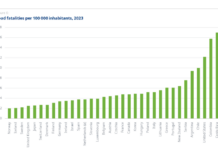In Photos: Celebrating Two Years of the Cycling Cities Campaign
ITDP launched the Cycling Cities campaign in 2021 to bring together a coalition of cities, partners, and pledge signers to work towards providing safe...
Why Cities Need to Invest in Active Mobility for the Climate and Economy
Current urbanization trends, rising incomes, and increased vehicle ownership are steering cities toward a future with 40% less travel by walking, cycling, and public...
Sustainable Mobility Up, Climate Emissions Down
Cities around the world are leading the way towards a sustainable future – but without rapid transformation, climate emissions will continue to rise. Give...
Investing in Safe Cycle Lanes is Crucial to Jakarta’s Mobility Future
During the height of the COVID-19 pandemic, Jakarta implemented pop-up protected cycle lanes as one of the strategic responses to the COVID-19 pandemic. Many...
Elevating the Role of Active Mobility at COP28
A note from Heather Thompson, CEO of ITDP, and Sheila Watson, Deputy Director of the FIA Foundation, on active mobility at COP28.The post Elevating...
Two Years In, ITDP’s Cycling Cities Campaign Continues to Make Moves
On the second anniversary of ITDP’s Cycling Cities campaign, it is a time to recognize the remarkable strides made by our partners and cities...
These Major Chinese Cities Are Making Moves On Cycling
With the particular increase in cycling during the pandemic, both for daily travel and goods delivery, cities across China had the opportunity to push...
These Major Chinese Cities Are Making Moves On Cycling
With the particular increase in cycling during the pandemic, both for daily travel and goods delivery, cities across China had the opportunity to push...
The Lane Ahead: Challenges and Considerations for China’s Cycling Sector
China has had a complex relationship with urban cycling throughout the past few decades. Now, a renewed demand for and interest in urban cycling...
In China’s Cities, A Return to Cycling Prioritizes People and the Climate
What does the future of ‘cycling cities’ look like for China, what unique challenges do they face, and how are cities already taking action?...










